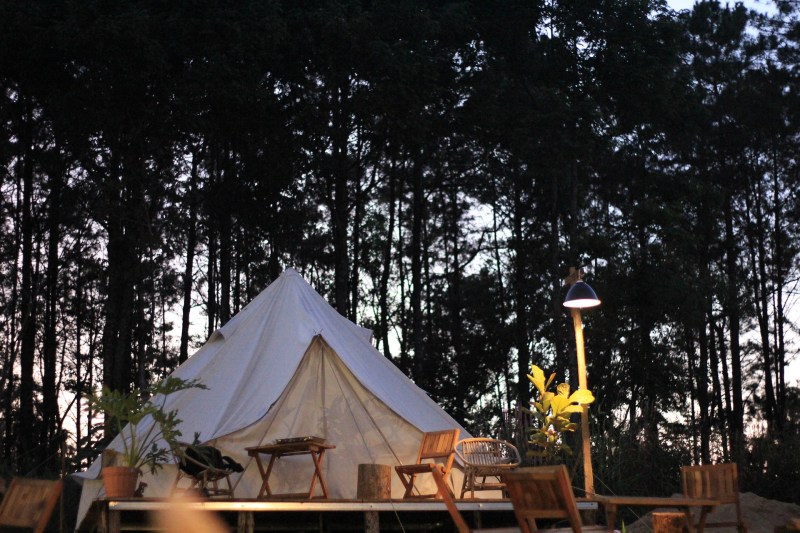
While there’s no solid line drawn between glamping vs. camping, glamping is a lot like Steve Buscemi or a rabid bear: You know it when you see it.
We like to think of glamping as a camping experience for anyone who’s an indoor person at heart. You enjoy all the warm and fuzzy parts of being outdoors: The peace and quiet of the wilderness, the crackle and pop of a burning fire, the day hikes, panoramic views, and proximity to wildlife. Who wouldn’t? All that “sleeping on the ground” and “eating out of a bag” stuff, though? That you can do without.
Look, we get it. Going three days without a shower isn’t everyone’s idea of a good time. Neither is crawling into a camping tent, eating dehydrated meals, or pooping in the woods. We’re not here to shame you. In fact, we’re here to help.
Below, we’ve broken down the three factors we feel most strongly differ between glamping and camping to help you decide which is more your style.
The camp kitchen: Food and drink
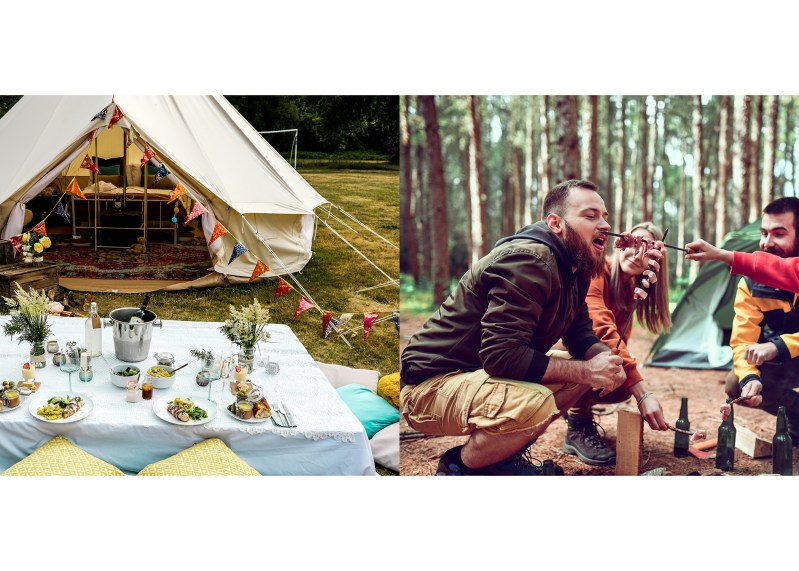
One clear indicator of camping vs glamping occurs when it’s time to make a meal, be it breakfast, lunch, or dinner. Not sure which is more your speed? Let’s try a quick mental exercise:
Take a moment to imagine your ideal camp kitchen. It’s dusk, everyone is starving after a long day of hiking, paddling, or biking, and looking forward to a hearty meal. When you picture the cooking operation around you, what do you see?
Is someone cranking up a two-burner propane stove?
If your ideal camp kitchen involves cooking on a legit gas range, multiple pots and pans, entrees and sides, and maybe even multiple-course meals, we’re going wager glamping is more your speed. You want the best camp cooking essentials, and you want them to look good during your camping experience.
Is food prep serious business?
How much effort is going into cooking a meal? Is there someone wielding a knife that wouldn’t look out of place in your kitchen at home? Is there a separate table being used solely for chopping vegetables? Is there even a chance anyone will be cooking with wine? Yeah, that’s glamping.
Is boiling water the only kind of “cooking” going on?
On the other side of the mobile camp kitchen continuum, your meals get a lot simpler and a lot less … well … glamourous. Don’t get us wrong, dehydrated camp meals have come a long way in the last decade. In fact, it’s tough to beat biscuits and gravy for breakfast or lemon herb mussels over a bed of instant rice or noodles for dinner. If you prefer spending less time preparing a meal, simple ingredients, and fewer dishes to keep up with and clean, though, you’re more the camping type.
Camping vs. glamping: Afterhours activities
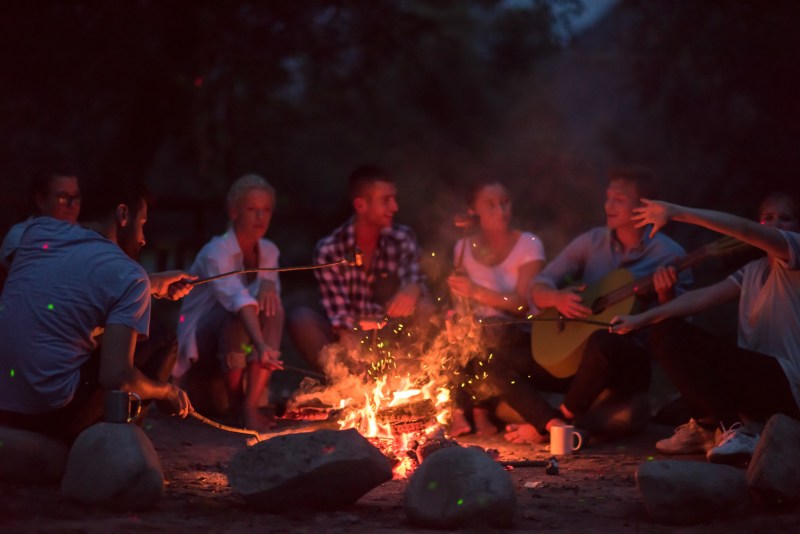
When the days’ plans have played out, the sun has set, and there’s nothing left to do but hang around camp with your friends, how you wind down after dark depends on your camping style, too.
Do your ideal after-hours activities involve electricity?
This one is a tell-tale sign of glamping for sure. Maybe it’s kicking back with a few snacks and watching a movie on your favorite mini-projector. Maybe it’s hanging inside of your well-lit yurt, RV, or dome tent and playing a board game with friends and family. If you require anything beyond a headlamp and maybe a wireless speaker after dark, you’re definitely leaning toward glamping.
Does sitting around a campfire for hours sound like a good time?
Absolutely not a trick question. Sitting around the glow of a nice fire with nothing but conversation and a few cold drinks from your well-packed camping cooler to keep you entertained is a hallmark of camping. Some campers feel a visceral need to poke and prod at the fire every ten minutes. Some are content to simply put their feet up and watch it burn.
Either way, electric devices of any description (aside from putting on a little music), from lights to smartphones, all become a nuisance. Afterhours for campers is all about swapping stories and sharing laughs until it’s time to crawl into the tent for the night. We can do that other stuff back in the real world.
Sleeping arrangements: Glamping vs. camping
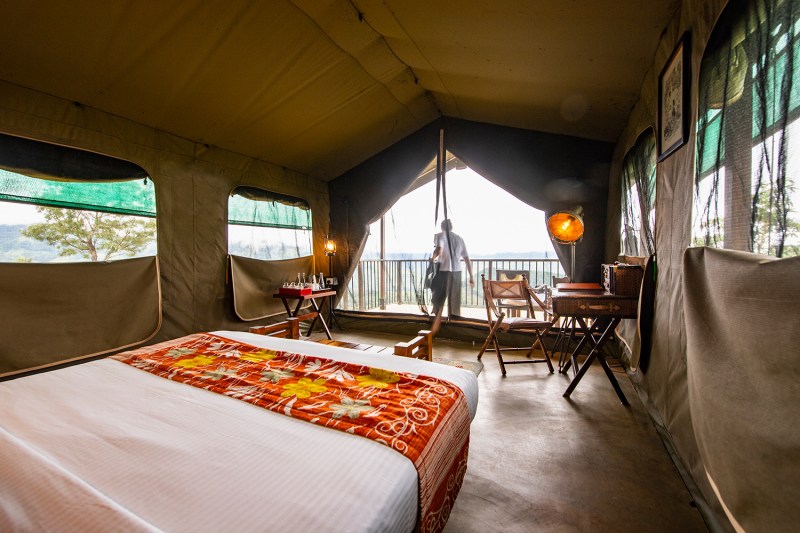
If there’s one thing both campers and glampers can agree on, it’s being much more comfortable at bedtime than your average backpacker. Both styles revolve around some form of car camping, so there’s no need to rely on minimalist tents, compact sleeping systems, or cramped sleeping bags. Still, there’s often a clear difference between the two when it comes to sleeping comfortably outdoors.
Does the thought of setting up camp seem like a chore?
Although camping tents just keep getting better every year, some folks simply prefer not to mess with setting one up. Or setting anything else up, for that matter. Instead, they lean toward pre-existing shelters or even completely pre-stocked rentals or campsites. Companies like Tentrr handle everything from setting up a giant shelter (complete with full-sized mattresses, heaters, nightstands, and even decor) to all the food and drink you’ll need for your stay.
Imagine pulling into camp and finding someone has already hauled out all the gear, set everything up, split all the firewood, packed the cooler, and set out the chairs and hammocks. There’s nothing left to do but relax and enjoy. It’s like that. And you know what? That’s glamping at its most extreme.
Prefer to bring your own mattress?
If setting up your sleeping arrangement starts with unrolling a camping sleeping pad and ends with you dizzy and close to fainting* from inflating it, you’re probably camping. Sleeping arrangements reminiscent of backpacking gear are a strong indicator that you’re roughing it to some degree.
If you’re pulling out at least one queen-size camping air mattress, inflating that bad boy with a high-powered air pump and piling on all the blankets, pillows, and throws your heart can stand, you’re probably leaning toward glamping, and that’s OK.
When did glamping become a thing?
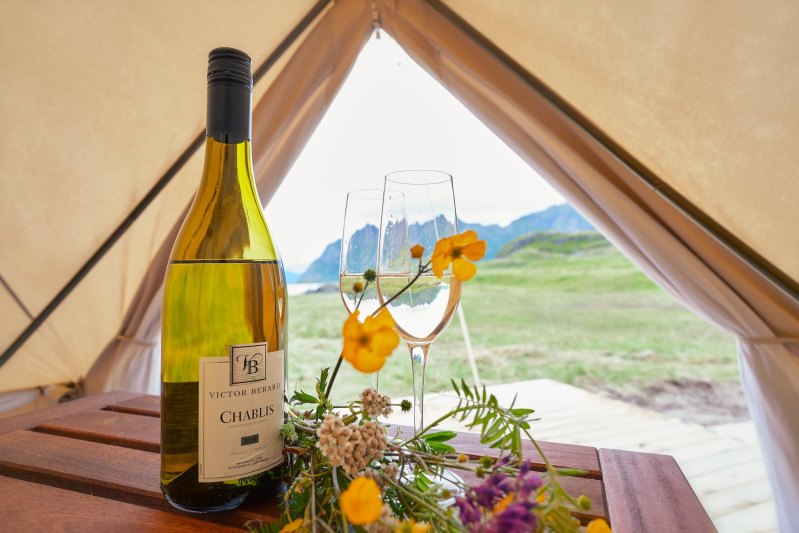
Actually, the concept of glamping (glamorous camping) has been around for centuries. Wealthy travelers have enjoyed decked-out tents and comfortable amenities in the outdoors for a long time. Here’s a breakdown of the timeline of glamping as a concept:
- Early 1900s: Affluent Europeans embarked on lavish camping trips, setting up plush tents with furniture and all the comforts of home.
- 1920s to 1930s: African safaris became popular among the wealthy, who brought along generators, bathtubs, and other luxuries.
- 1950s to 1980s: The idea of glamping continued to grow in popularity, especially among those seeking a more comfortable way to experience nature.
The term “glamping” itself is a recent “invention:”
- 2005: The word “glamping” first appeared in the U.K.
- 2007: Google Trends data shows a surge in searches for “glamping,” primarily from Ireland and the U.K.
- 2010s: Glamping gained significant traction worldwide, with the term being added to the Oxford English Dictionary in 2016.
So, while the idea of luxurious or glamorous camping has a long history, the term “glamping” is a recent development that reflects the growing popularity of this way of experiencing the outdoors.



